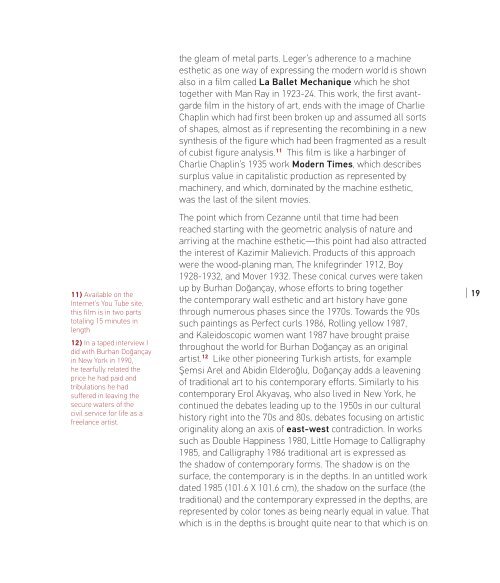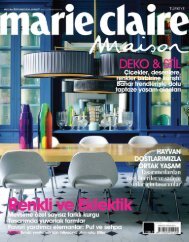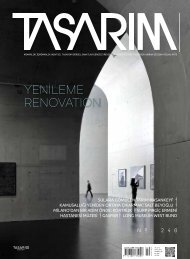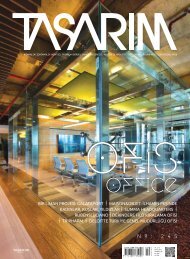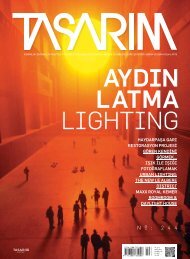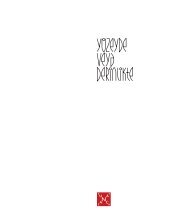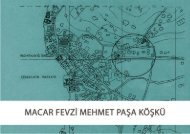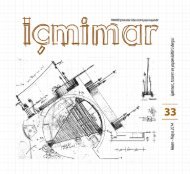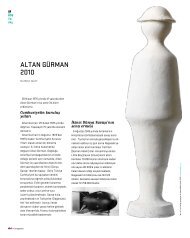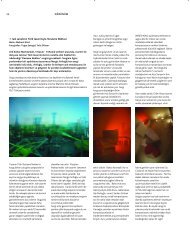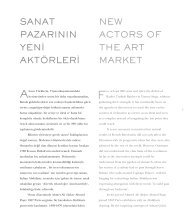SURET-SİZ
Tunca Sanat'ın 15 Aralık 2010 - 30 Ocak 2011 tarihleri arasında düzenlediği “Suret-siz’’ adlı sergisi için Mahmut Nüvit'in kaleme aldığı yazısı...
Tunca Sanat'ın 15 Aralık 2010 - 30 Ocak 2011 tarihleri arasında düzenlediği “Suret-siz’’ adlı sergisi için Mahmut Nüvit'in kaleme aldığı yazısı...
You also want an ePaper? Increase the reach of your titles
YUMPU automatically turns print PDFs into web optimized ePapers that Google loves.
11) Available on the<br />
Internet’s You Tube site,<br />
this film is in two parts<br />
totaling 15 minutes in<br />
length<br />
12) In a taped interview I<br />
did with Burhan Doğançay<br />
in New York in 1990,<br />
he tearfully related the<br />
price he had paid and<br />
tribulations he had<br />
suffered in leaving the<br />
secure waters of the<br />
civil service for life as a<br />
freelance artist.<br />
the gleam of metal parts. Leger’s adherence to a machine<br />
esthetic as one way of expressing the modern world is shown<br />
also in a film called La Ballet Mechanique which he shot<br />
together with Man Ray in 1923-24. This work, the first avantgarde<br />
film in the history of art, ends with the image of Charlie<br />
Chaplin which had first been broken up and assumed all sorts<br />
of shapes, almost as if representing the recombining in a new<br />
synthesis of the figure which had been fragmented as a result<br />
of cubist figure analysis. 11 This film is like a harbinger of<br />
Charlie Chaplin’s 1935 work Modern Times, which describes<br />
surplus value in capitalistic production as represented by<br />
machinery, and which, dominated by the machine esthetic,<br />
was the last of the silent movies.<br />
The point which from Cezanne until that time had been<br />
reached starting with the geometric analysis of nature and<br />
arriving at the machine esthetic—this point had also attracted<br />
the interest of Kazimir Malievich. Products of this approach<br />
were the wood-planing man, The knifegrinder 1912, Boy<br />
1928-1932, and Mover 1932. These conical curves were taken<br />
up by Burhan Doğançay, whose efforts to bring together<br />
the contemporary wall esthetic and art history have gone<br />
through numerous phases since the 1970s. Towards the 90s<br />
such paintings as Perfect curls 1986, Rolling yellow 1987,<br />
and Kaleidoscopic women want 1987 have brought praise<br />
throughout the world for Burhan Doğançay as an original<br />
artist. 12 Like other pioneering Turkish artists, for example<br />
Şemsi Arel and Abidin Elderoğlu, Doğançay adds a leavening<br />
of traditional art to his contemporary efforts. Similarly to his<br />
contemporary Erol Akyavaş, who also lived in New York, he<br />
continued the debates leading up to the 1950s in our cultural<br />
history right into the 70s and 80s, debates focusing on artistic<br />
originality along an axis of east-west contradiction. In works<br />
such as Double Happiness 1980, Little Homage to Calligraphy<br />
1985, and Calligraphy 1986 traditional art is expressed as<br />
the shadow of contemporary forms. The shadow is on the<br />
surface, the contemporary is in the depths. In an untitled work<br />
dated 1985 (101.6 X 101.6 cm), the shadow on the surface (the<br />
traditional) and the contemporary expressed in the depths, are<br />
represented by color tones as being nearly equal in value. That<br />
which is in the depths is brought quite near to that which is on<br />
| 19


